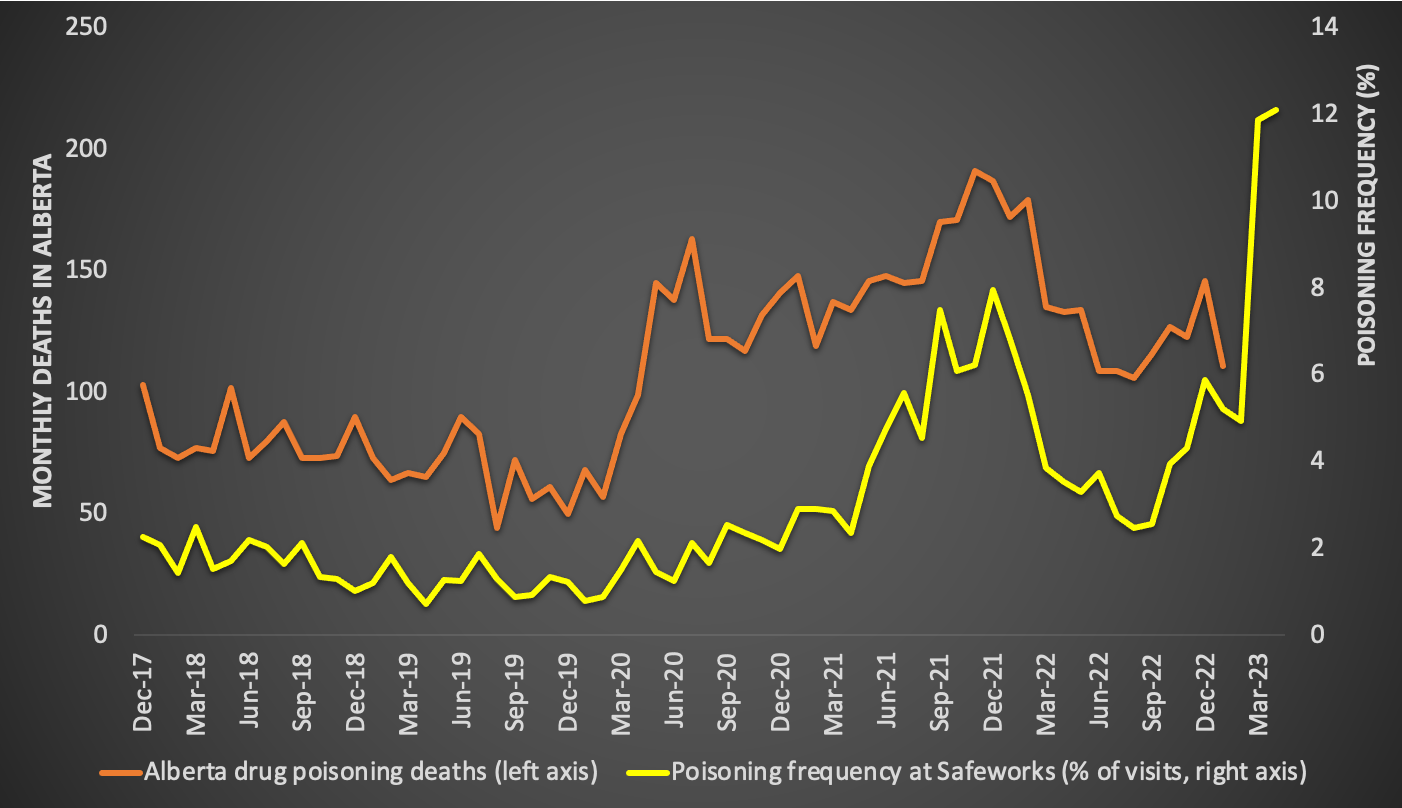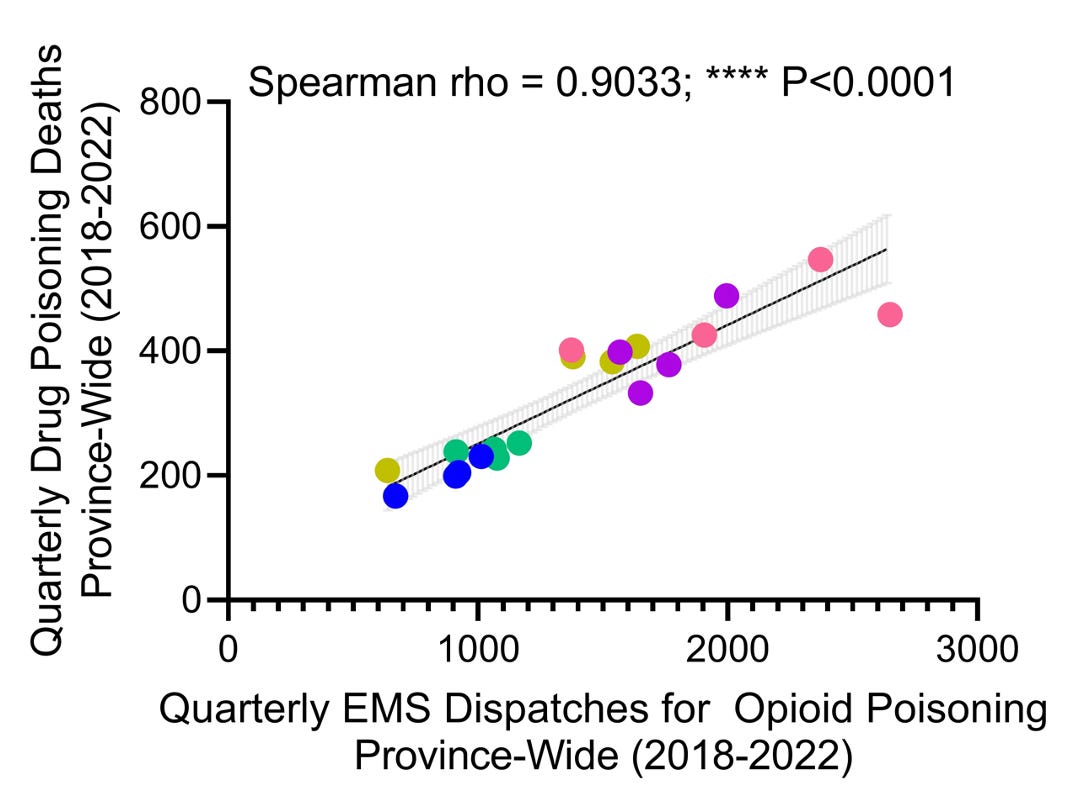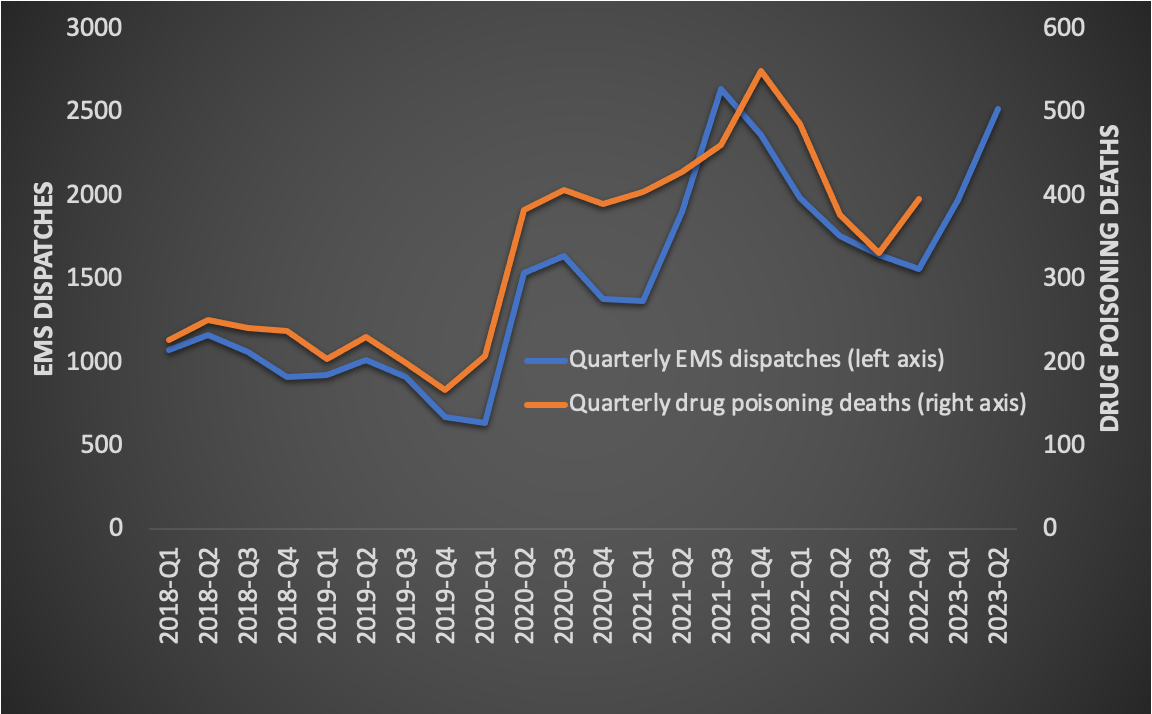Is drug poisoning reaching new heights in Alberta?
We won't get updated mortality counts before the election, but EMS and supervised consumption data tell us the situation is bad as ever.

The UCP government has done its best over the last year to capitalize on the idea that their “treatment” interventions, which largely haven’t materialized, have made a significant difference in opioid poisonings across Alberta.
Now, we can dispute which interventions work for drug toxicity and which don't, but first it's important to challenge any assumption about whether we’ve put any part of the drug poisoning emergency behind us.
Yes — there was an apparent decrease in drug poisoning from 2021 to 2022 of about 12% (though updates are still coming), but this was matched in other provinces: without supply regulation, people remain at the mercy of drug supply toxicity.
I’ve seen the current severity of the supply toxicity — 30-year opioid veterans being knocked off their feet, the strength of the supply taking them by surprise. In late April, a single outreach team conducted fourteen overdose responses in one hour near Calgary Drop-In.
Meanwhile, Calgary Drop-In reported a near-tripling of overdose rates at the facility. It got so bad that an alert went out province-wide describing record-breaking EMS dispatches for drug poisoning in Calgary: 95 in a single week.
But, as UofA PhD student Holly Mathias points out in a May 24 opinion piece, data transparency remains a serious issue in Alberta. It’s now almost June, but we don’t even have an estimate for how many died in February or March.
Fortunately, we’ve learned enough to make educated forecasts.
EMS dispatches correlate closely with mortality
Weekly EMS dispatches for drug poisoning are shown in Alberta’s Substance Use Surveillance System, but to my knowledge, no one is using this as an indicator of mortalities. This would be useful in forecasting and, under a government that believed in such things, flexible harm reduction resource deployment.
As it turns out, EMS dispatches and drug poisoning mortalities correlate almost perfectly between 2018 and 2022. Here's the available data compiled quarterly (done this way because EMS data are provided by week, while mortality data are provided by month).

Plotting the mortalities and EMS dispatch together through this period gives us our current bearing. Note that the 2023-Q2 EMS dispatch data point is projected from the first six weeks of the quarter.

Far from showing an emergency being brought under control, these data convey that we are entering the most deadly phase of the crisis to date — just as Albertans are set to determine the next four years of drug policy decision-making. If these data are predictive of mortality — and the first figure above seems to suggest as much — we could see the fifth- and second-highest drug poisoning mortalities on record for the first and second quarters of 2023.
This matches what outreach groups and social agencies have been telling us.
Supervised consumption overdose rates: even worse
Since last summer, I’ve kept an eye on drug poisoning (or overdose) at Safeworks, Calgary’s only supervised consumption site. Safeworks does not have inhalation booths, which means people cannot consume drugs by smoking — not ideal, given the widespread understanding that the majority of poisonings occur after smoking.
But, like EMS dispatches, the frequency of poisonings at Safeworks also correlates closely with the provincial death rate. This tells us that Alberta’s largest city likely has drug supply toxicity that is mirrored provincially.
Every month, Safeworks staff release a report detailing the number of people who enter the facility and experience a poisoning. We’re currently seeing a poisoning rate at Safeworks of 12% — the yellow line that climbs rapidly on the right. It’s 50% higher than the previous high of 8%, set in December 2021.

It’s painful to think about what these figures indicate.
Many of us have spent the last years trying to explain to the media, to the public, to politicians and anyone who will listen: by allocating our resources almost entirely on an ill-defined notion of “recovery,” we abandon people who use drugs to the mercy of supply toxicity.
As all of these data make clear, people were already dying at nearly unprecedented rates before this latest wave of toxicity.
Regulating the drug supply is no longer a moral question. It’s no longer an ethical one.
The talking heads making noise about the “risks” of prescribing regulated opioids to people who already use them are simply not being honest in their assessment of risk.
And yes, that includes the entire UCP government, who spent over a year building a false case against safe supply. Four years casting doubt on supervised consumption services and destroying those services they could.
Four years and thousands of lives wasted — for what? Growth prospects for police and addiction treatment providers?
What comfort comes from shoring up your moral bias with dead bodies?
It’s been a busy couple weeks: if you’re looking for more, check out my interview on Native Calgarian Podcast out May 24 as well as an upcoming discussion on Alberta Advantage.





